Principales tendances en matière de récompenses en 2025
Découvrez pourquoi les programmes de récompenses sont essentiels en 2025. Découvrez les tendances, les stratégies et les avantages pour les employés, les clients et les entreprises afin de stimuler la croissance et la fidélité.
Sur cette page
- Pourquoi les récompenses sont-elles importantes en 2025 ?
- Qu'est-ce qu'une récompense en 2025 ?
- Les changements qui façonneront les récompenses en 2025
- Principales tendances en matière de rémunération en 2025
- Les principaux objectifs de récompense en 2025
- Principale catégorie de récompenses en 2025
- 9 Grandes idées de récompenses en 2025
Les clients veulent qu'on se souvienne d'eux. Les employés veulent être reconnus. Les équipes de vente veulent être rechargées.
Depuis qu'Henry Ford a commencé à récompenser les personnes qui ne quittaient pas l'entreprise au début des années 1900, la motivation a fonctionné différemment selon les personnes. Nous avons parcouru un long chemin depuis.
À l'aube de l'année 2025, certaines choses n'ont cependant pas changé. Les récompenses continuent de motiver les humains comme peu d'autres choses peuvent le faire. Et le sentiment d'être apprécié et valorisé continue de nourrir la stratégie.
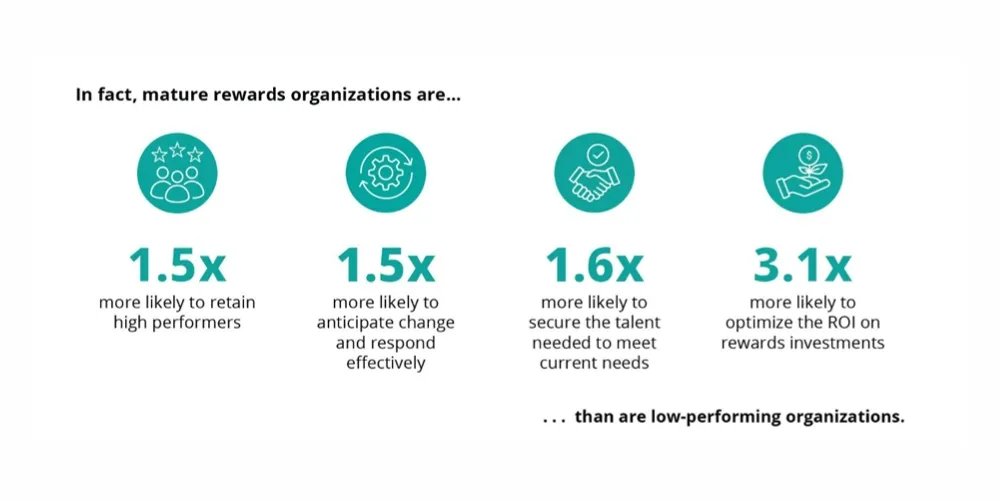
Pourquoi les récompenses sont-elles importantes en 2025 ?
Une feuille de route de récompenses exécutée de manière experte permet d'impliquer les acteurs clés de l'entreprise, de renforcer l'avantage concurrentiel et de promouvoir durablement la marque.
1. Les travailleurs
81% des employés avouent être plus motivés lorsque leur patron leur témoigne de la reconnaissance. Et ce n'est pas tout. Les entreprises qui maîtrisent l'art de la reconnaissance des employés sont également 12 fois plus susceptibles de générer des résultats commerciaux solides que leurs homologues qui ne le font pas.
2. Canaux
La récompense des ventes est une activité clé pour 90 % des entreprises les plus performantes. Et 84 % des consommateurs avouent qu'ils resteront fidèles à une marque qui a mis en place un programme de fidélisation.
3. Les clients
Selon Forbes, les clients fidèles sont non seulement 50 % plus susceptibles d' essayer un nouveau produit, mais ils sont aussi 31 % plus enclins à dépenser du pognon que les nouveaux clients.
4. Pare à jouer
La règle des 80/20 de Pareto s'applique également au commerce. Sachant que 80 % des consommateurs génèrent 20 % du chiffre d'affaires, il est facile de comprendre pourquoi les organisations intelligentes tirent parti de la psychologie de l'éloge pour susciter des comportements souhaitables sur un marché concurrentiel où l'attention est inconstante.
Ce faisant, ils répondent également à des critères commerciaux importants tels que les coûts, le taux de désabonnement et le chiffre d'affaires. Faites une recherche sur le nom d'une marque avec le mot-clé "récompenses" ou "programme de récompenses" et 9 fois sur 10, elle apparaîtra sur Google - Amazon, Nike, Disney, tout le monde est sur la liste !
En savoir plus sur l'impact et les avantages des récompenses sur le lieu de travail et comment un programme de fidélisation programme de fidélisation B2B bien structuré bien structuré et proposant les bonnes récompenses peut changer la donne pour votre entreprise.
Qu'est-ce qu'une récompense en 2025 ?
La définition ne cesse d'évoluer. Les années 2000 nous ont offert des programmes de reconnaissance formels et descendants, avec des récompenses matérielles telles que des promotions, des primes et des certificats.
Les années 2010 ont vu l'émergence desrécompenses non monétaires, plébiscitées par 65 % des salariésCes récompenses se traduisent par des opportunités de croissance, de reconnaissance sociale et d'équilibre entre vie professionnelle et vie privée.
Nous vivons aujourd'hui une époque sophistiquée où l'essor de la technologie, des idées et de l'individualisme bouleverse les définitions du travail et de la détente. La façon dont nous exprimons et acceptons la reconnaissance est en pleine révolution.
Le monde s'éloigne de la "profondeur de la peau" pour saisir l'essence riche et multitexturée de la personnalité dans son ensemble - et concevoir des récompenses en conséquence. Le bien-être, les passions intrinsèques, la responsabilisation, l'appartenance, l'objectif et la croissance sont les mots à la mode à l'horizon 2025.
Les programmes de récompense réagissent en expérimentant de manière dynamique de nouveaux ingrédients et de nouvelles équations pour parvenir à une formule qui maximise la bonne volonté, renforce l'attachement et encourage les associations et les affaires répétées.
Les changements qui façonneront les récompenses en 2025
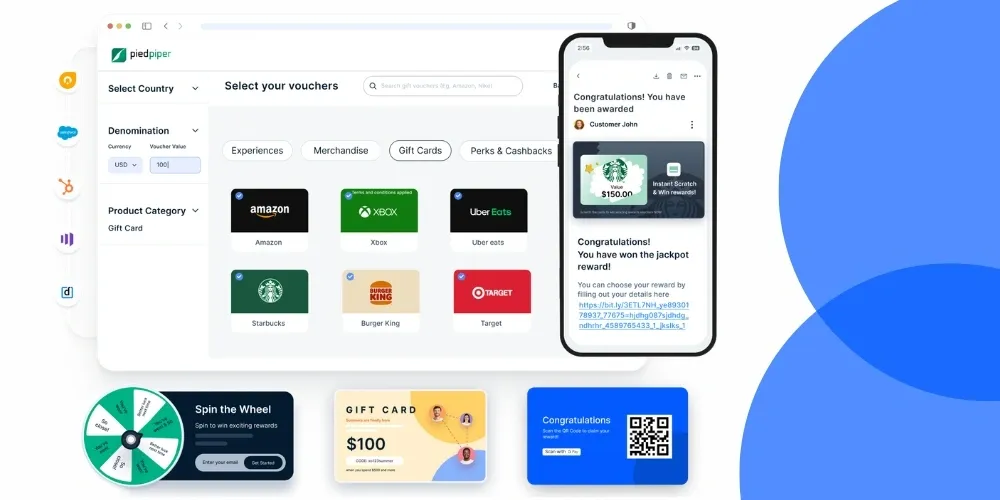
Une étude de Deloitte a mis en évidence un changement de perception avec un NPS sur les récompenses qui a grimpé en flèche, passant d'un mauvais score négatif de 15 à un score positif de 36. L'année 2025 renforcera encore l'écart, car les dirigeants reconnaîtront que leurs services de rémunération sont une source de profit et non un coût irrécupérable.
En 2025, les meilleurs programmes de rémunération seront axés sur les données, nuancés et agiles. Ils seront ciblés au laser sur la réalisation des objectifs de l'organisationIls auront une proposition de valeur claire et seront planifiés comme des entités évoluant de manière dynamique, capables de s'adapter aux tendances et aux perturbations en cours de route avec un minimum d'agitation.
Voici quelques caractéristiques que l'on peut s'attendre à trouver dans les cadres de rémunération les plus performants à l'avenir.
Principales tendances en matière de rémunération en 2025
1. Héritage libre
En cette nouvelle année, les leaders de la rémunération tournés vers l'avenir ne s'encombreront pas de systèmes existants et choisiront plutôt de se tourner vers l'avenir. Ils adopteront sans crainte les nouvelles technologies, les nouveaux modèles d'engagement et les nouvelles tendances pour rester compétitifs tout en exploitant pleinement le potentiel de leurs systèmes de rémunération.
Avec la baisse des coûts informatiques et l'IA qui démocratise la technologie comme jamais auparavant, même les petites marques ont maintenant la possibilité d'obtenir un engagement et une fidélité extraordinaires en combinant leur stratégie de récompenses avec la bonne pile technologique, ou en s'associant avec la bonne plateforme technologique de récompenses telle que Xoxoday.
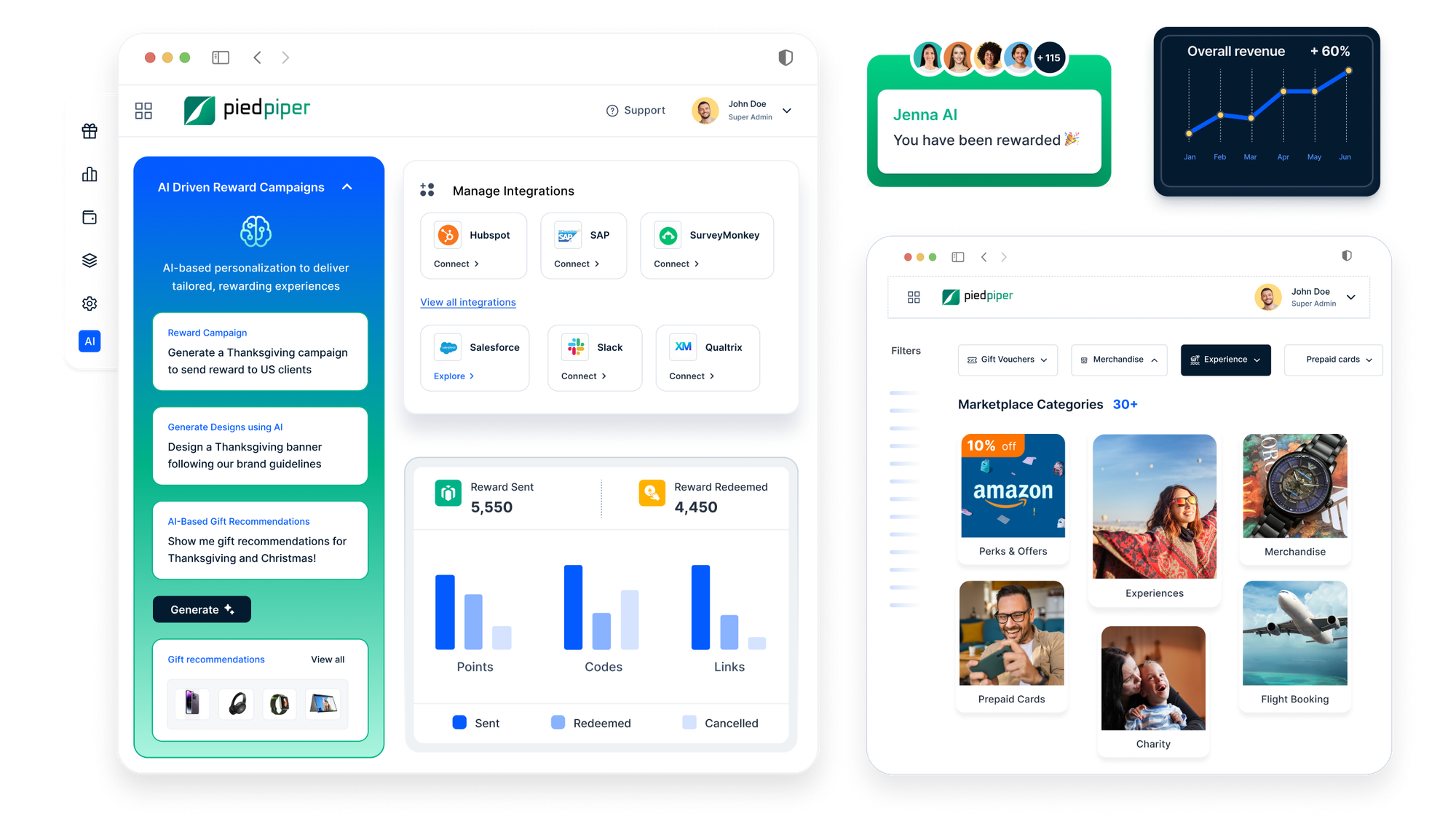
2. Holistique
Les récompenses deviennent de plus en plus multidimensionnellesLes récompenses sont de plus en plus multidimensionnelles et couvrent un large éventail de domaines, notamment la santé physique, mentale, sociale et financière. Les horaires flexibles, l'aide à la garde d'enfants, l'amélioration des compétences, l'aide à la retraite et d'autres avantagesmarginaux sont sous les feux de la rampe.
Les véritables récompenses seront "totales dans l'esprit", c'est-à-dire qu'elles donneront aux individus les moyens d'agir en tenant compte à la fois de leurs caractéristiques extrinsèques et intrinsèques. extrinsèques et intrinsèques et intrinsèques.
3. Participation à la vie de l'entreprise
Qu'il s'agisse de gestion active ou d'implication des pairs 41% des salariés souhaitent une reconnaissance de la part d'un pair) qui encourage les éloges en public 50 % des salariés Les programmes de récompense de 2025 seront conçus pour s'épanouir dans des environnements collaboratifs et co-créés.
4. Communication
L'écoute, le partage et le microapprentissage apparaissent rapidement comme les piliers de l'architecture moderne des récompenses.
Les messages, les encouragements et les alertes - intégrés dans le tissu des flux de travail et des entonnoirs de marketing - favorisent des écosystèmes étroitement liés qui informent, examinent et récompensent. Le travail à distance mobilisant des employés du monde entier et des clients venant de différentes parties du monde, les pratiques et politiques commerciales ont désormais pour mission de répondre à un ensemble diversifié d'attentes. de manière synchrone en temps quasi réel.
5. Reconnaissance des hautes fréquences
Dans le prolongement du point précédent, nous constatons que les entreprises se tournent vers des plateformes telles que Zoom, Slack, Teams et les médias sociaux (entonnoirs privés et dark social) pour entretenir haute fréquence à haute fréquence.
L'objectif est de célébrer le retour d'information et la gratitude dans l'instant, d'impliquer les employés et les clients "là où ils se trouvent" et d'intégrer la gratification instantanée dans les procédures et les flux de travail quotidiens.
6. Tech premier
En 2025, les responsables des récompenses les manieront comme une baguette magique : Ils s'attaqueront à des goulets d'étranglement tenaces et atteindront des objectifs jusqu'ici considérés comme impossibles.
L'adoption des dernières pratiques numériques les aidera à mettre en place des mécanismes de récompense intelligemment ciblés, profondément personnalisés, agréables à utiliser, hybrides et respectueux de la vie privée.
7. Sensible
Le travail à distance mobilisant des employés du monde entier et des clients venant de différentes parties du monde, les pratiques et les politiques des entreprises ont désormais pour mission de répondre à un ensemble diversifié d'attentes.
Ils doivent être sensibles à la culture, respectueux de l'individualité, justes, équitables et offrir une liberté de choix. Souple et décentralisés sont à la mode, créant des environnements où les membres ont plus d'autonomie et de contrôle que jamais sur la manière dont ils sont récompensés.
8. Variété
Une étude de Deloitte considère le "choix des options pour l'échange de points" comme une caractéristique à forte valeur ajoutée. une caractéristique de grande valeur dans le contexte de la participation à un programme de fidélisation.
En 2025, les points, les paliers, les codes, les cartes, les réductions, les bons prépayés et les places de marché nous donneront l'embarras du choix, les entreprises proposant un buffet somptueux de récompenses innovantes.
Une plateforme de récompenses de premier plan Plum permet aux bénéficiaires de comparer et de choisir parmi plus d'un million de récompenses personnalisables dans plus de 100 pays et plus de 30 catégories, ce qui permet aux marques de créer des programmes d'incitation quels que soient leur stratégie, leur idée ou leur budget.
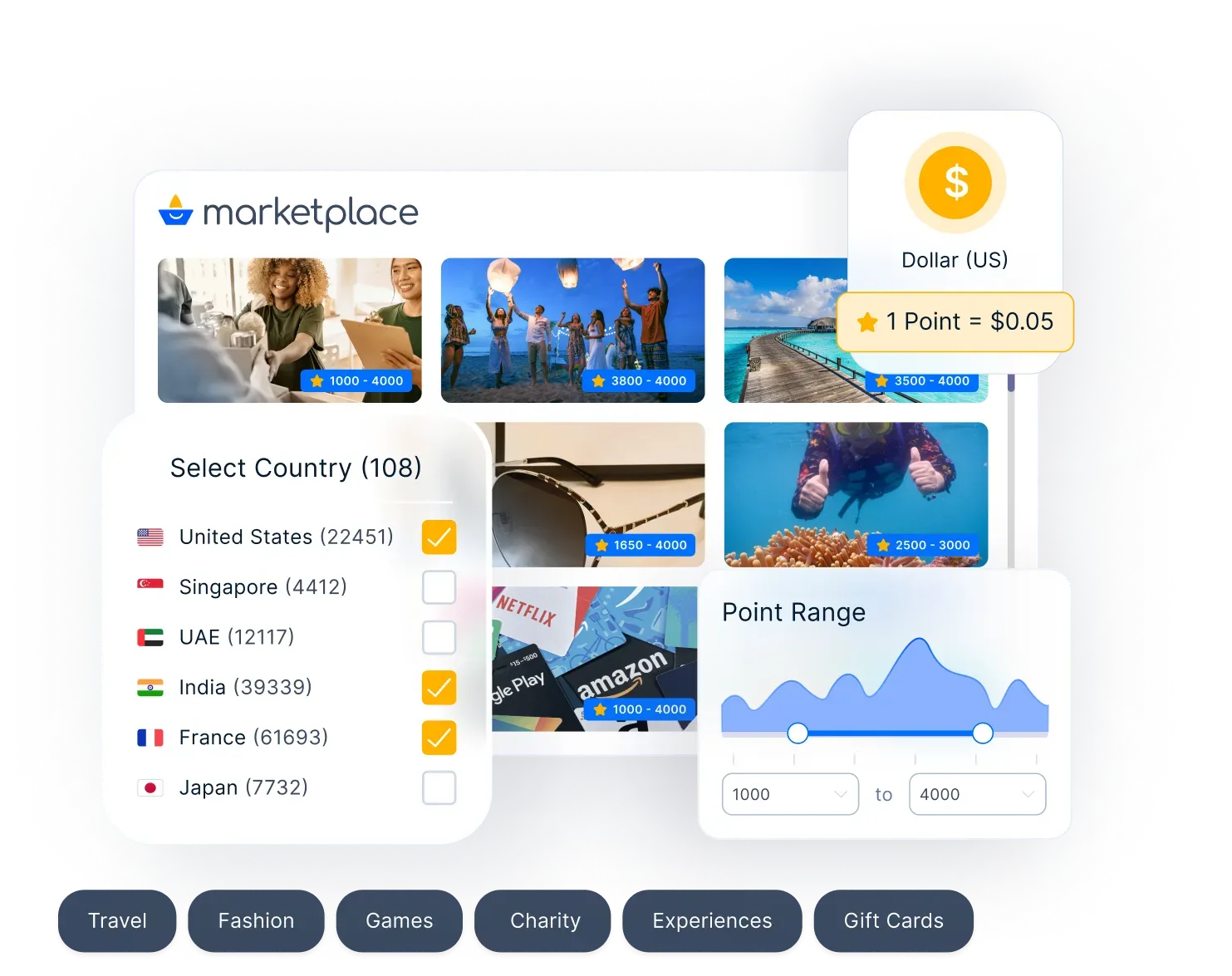
9. Délestage R & R
Le couple familier - récompenses et reconnaissance - pourrait enfin se dissocier. Alors que les récompenses sont plus formelles, les actes de reconnaissance quotidiens, tels que les brise-glace, les tapes dans le dos et les moments de plaisir, sont de plus en plus considérés comme des "gestes de pouvoir" à part entière.
Cette plateforme permet aux organisations de faire la différence entre les récompenses formelles et la reconnaissance informelle, en répondant aux diverses motivations des employés grâce à des offres personnalisées et flexibles.
10. En personne
Une étude indique qu'un sentiment d'appartenance sur le lieu de travail peut conduire à 50 % de réduction du risque de turnover. Alors que les formats de travail au bureau reviennent à la mode, les entreprises profitent de l'occasion pour créer des moments uniques de face-à-face qui offrent un choix tout en favorisant la magie de la connexion en personne.
Les enjeux communs et les objectifs partagés sont intégrés dans la structure des récompenses afin que la reconnaissance se sente authentique et spéciale.
11. Prompt
Tom Petty a chanté Waiting Is The Hardest Part en 1981. De nouvelles études montrent que notre dégoût pour les retards n'a pas diminué d'un iota. Les managers capitaliseront donc sur le rythme et l'élan de la victoire en répondant rapidement aux attentes en 2025. Après tout, une reconnaissance retardée est une reconnaissance refusée.
12. Hébergement
Les employeurs seront attentifs aux structures plus plates, aux flux de travail agiles, aux fonctions matricielles, aux modes hybrides, à la main-d'œuvre occasionnelle, aux changements réglementaires, aux parcours de carrière non linéaires et à l'évolution des perspectives générationnelles pour créer des structures de rémunération flexibles.
13. En continu
Nous passons des réactions instinctives et des gestes ponctuels à des environnements omni-canaux, interconnectés et toujours actifs, qui transforment le geste de récompenser en habitude. Le suivi et la mesure en temps réel soutiendront la transition, en affinant l'impact sans relâche.
14. Hyper-simple
Shopify se classe commodité comme l'une des meilleures stratégies pour maintenir l'engagement des clients dans les programmes de fidélisation. En 2025, les programmes de récompenses seront transparents, faciles à comprendre, et il sera aisé d'y adhérer et d'y participer.
Les leaders intégreront de manière transparente les récompenses dans les actions quotidiennes (en supprimant, par exemple, la nécessité de s'inscrire et d'interagir séparément), automatiseront le suivi des points et veilleront à ce que les systèmes d'information et de communication ne soient pas trop encombrants et inhospitaliers, et à ce qu'il n'y ait pas d'obstacles à leur utilisation. UX soit enfin une chose du passé.
Les points de friction seront systématiquement supprimés : Norwegian Air Shuttle et Strawberry Hotelspar exemple, gèrent une monnaie loyale commune qui évite aux membres de passer d'un programme à l'autre, tandis que British Airways et Finnair permettent aux membres de gagner des points auprès de l'une ou l'autre compagnie lorsqu'ils prennent l'avion.
15. En dehors de la boîte
Les entreprises vont au-delà des incitations et des primes traditionnelles pour rendre l'acte de reconnaissance plus immersif, plus significatif et plus innovant. Elles donneront la priorité à l'adaptation contextuelle pour créer un plaisir au niveau du doux nexus de la surprise et de la joie.
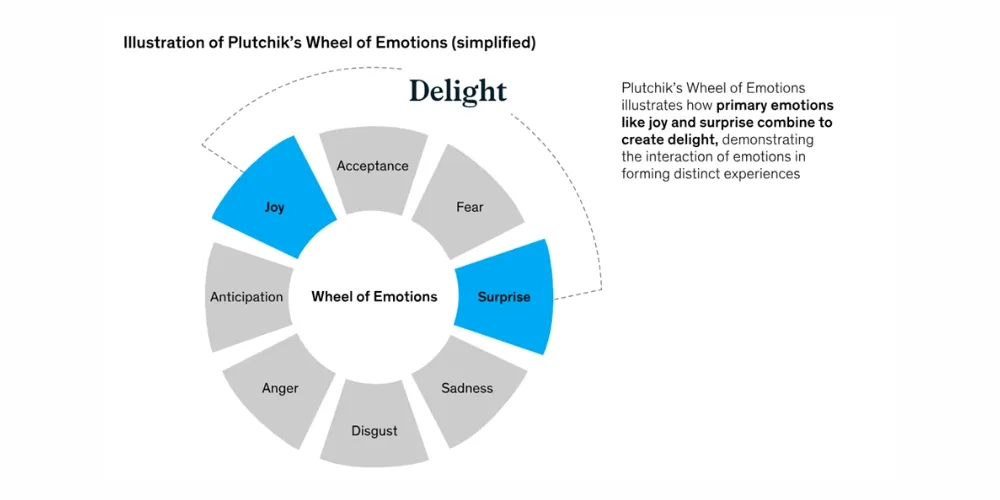
16. Responsable
En 2025, les programmes de récompenses ont l'obligation d'être socialement conscients, respectueux de l'environnement, de traiter les questions de diversité et d'inclusion, de s'élever contre les pratiques iniques (comme la cruauté envers les animaux et le travail des enfants) et de rester attentifs aux besoins exprimés et non exprimés de la société et de la communauté dans son ensemble. Les entreprises qui associent des objectifs ESG à des systèmes de récompense verront les parties prenantes les accepter spontanément.
17. Axé sur les résultats
En 2025, les programmes de récompense et de fidélisation seront étroitement liés à des résultats mesurables, qu'il s'agisse de l'engagement des fans, de l'augmentation du nombre de membres, des demandes de démonstrations, des conversions de ventes ou de la croissance du chiffre d'affaires. Les stratégies qui ne fonctionnent pas seront impitoyablement mises de côté. L'expérimentation et l'improvisation prendront de l'ampleur.
Les principaux objectifs de récompense en 2025
- Transformation numérique et technologique.
- Amélioration de la CLV : Customer Lifetime Value (valeur à vie du client).
- Augmentation de la fréquence d'engagement.
- Innovation et restructuration.
- Plus de fidélisation, moins de désabonnement.
- Simplicité et commodité.
- Partenariats stratégiques.
- Modèles d'abonnement payant.
- Augmentation des revenus et du retour sur investissement.
Principale catégorie de récompenses en 2025
- Commerce de détail et achats.
- Nourriture et boissons.
- Bien-être et remise en forme.
- Beauté et cosmétiques.
- Vêtements et accessoires.
- Voyages et hôtellerie.
- Contenu et abonnements.
- Aventure et activités.
- Gadgets et jeux.
- Amélioration de l'habitat et du cadre de vie.
- Chefs-d'œuvre et objets de collection.
- Divertissements, films et spectacles.
- Passe-temps, kits et cours de formation professionnelle.
- Événements spéciaux, rencontres avec des célébrités et occasions de la page 3.
Expériences inédites : participation à des festivals locaux, visites de destinations moins connues, randonnées au clair de lune, dégustations, concerts privés, etc, les voyages inspirés par les jeuxdes graffitis en public, des vols en montgolfière, des séances de réalité virtuelle et de réalité augmentée, des séjours dans une ferme, la photographie par drone, des accès exclusifs, l'apprentissage d'un maestro, etc. Voyages dans l'espace et promenades sur la lune ? Restez à l'écoute, ils seront bientôt au menu !
9 Grandes idées de récompenses en 2025
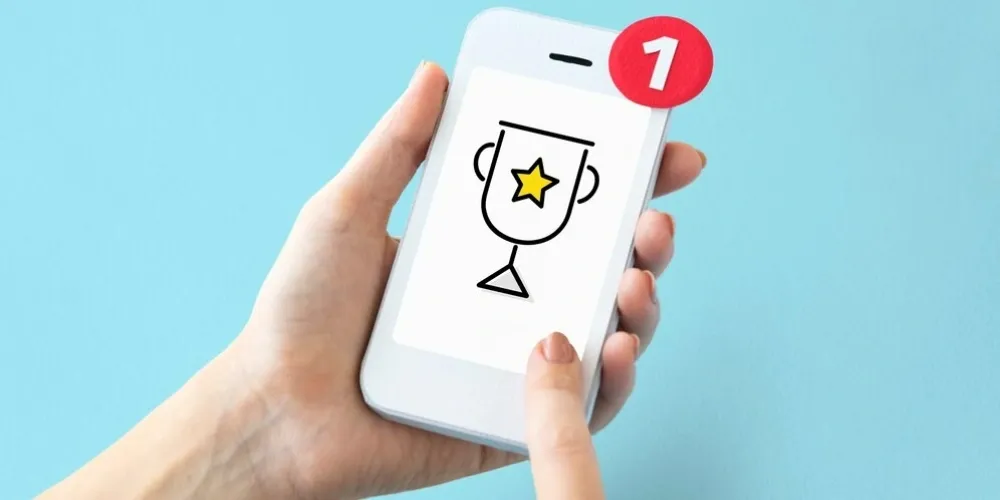
1. Retours, s'il vous plaît
Dans une économie confrontée aux vents contraires de l'incertitude et de la compression des marges, le retour sur investissement (ROI) sera un mantra majeur pour les organisations en 2025.
Les programmes de rémunération, soumis à la pression d'une meilleure valorisation, devront faire l'objet de recherches approfondies en termes de technologie, de modèles d'engagement et d'avantages finaux afin de justifier l'investissement de budgets, de ressources et de temps.
La stratégie de rémunération doit combiner les bons outils, mécanismes et plateformes pour réduire le décalage avec les systèmes de CRM / CDP, l'automatisation et le moteur de recommandation et faire progresser les objectifs commerciaux plus larges sans friction.
2. Plus d'amour
En 2025, les entreprises chercheront à susciter un amour inconditionnel pour leur marque - ce que font magistralement des entreprises comme Tesla, Nike et Apple. Elles concevront des "moments de marque" proches des valeurs, des aspirations et des modes de vie des clients et des employés afin de renforcer le lien avec l'identité de la marque.
Les applications et les analyses permettront aux marques d'intégrer intelligemment des leviers émotionnels aux points clés du parcours.
Par exemple, la technologie GPS, les capteurs et les traqueurs peuvent détecter quand les membres participent à des activités pertinentes, et les marques s'empresseront de les cibler à ce moment-là.
Marque de surf Rip Curl et la compagnie d'assurance Discovery Vitality récompensent leurs membres lorsqu'ils font du sport ou de l'exercice.
Par le biais de jeux interactifs, de concours LIVE ou d'actes quotidiens de bonne volonté, les marques ajouteront constamment du sens à l'instant présent en co-construisant des expériences.
L'objectif est de créer un sentiment d'accomplissement et de réussite, de resserrer les liens avec les communautés et de renforcer l'attachement à long terme. Un peu comme comment Lays a obtenu des légendes du football David Beckham et Thierry Henry qu'ils détournent l'attention vers leurs chips dans un stade rempli de supporters.
3. Hyper personnalisation
En 2025, les gens veulent être traités comme des individus uniques et distincts, et non comme des numéros ou des codes de couleur. Selon McKinsey, 76 % des consommateurs estiment que la personnalisation augmente leurs chances d'acheter, et 78 % d'entre eux sont susceptibles de ré-acheter.
D'après statista, un mammouth 97 % des entreprises en ont pris note et proposent déjà des expériences personnalisées. Le dernier rapport d'Adobe montre que 68 % des efforts de personnalisation ont dépassé leurs objectifs.
Alors que les approches à l'emporte-pièce disparaissent, la compréhension de l'individu à un niveau authentique et personnel, et la prise en compte de ses motivations et préférences réelles ne feront que croître.
Les entreprises utiliseront l'IA, les outils d'écoute, les analyses avancées, l'automatisation, l'intégration technologique et les chat-bots pour pivoter et proposer des offres pertinentes, des conversations qui résonnent et des expériences sur mesure.
La personnalisation transformera les clients et les employés en actifs commerciaux à long terme, en établissant une corrélation directe entre les programmes de récompenses et la valeur à vie des clients (CLV).
Uber offre des incitations personnalisées aux chauffeurs et aux passagers en fonction de leur activité. Enfin, Amazon exploite les données de l'historique de ses clients pour personnaliser ses recommandations.
4. L'intelligence artificielle
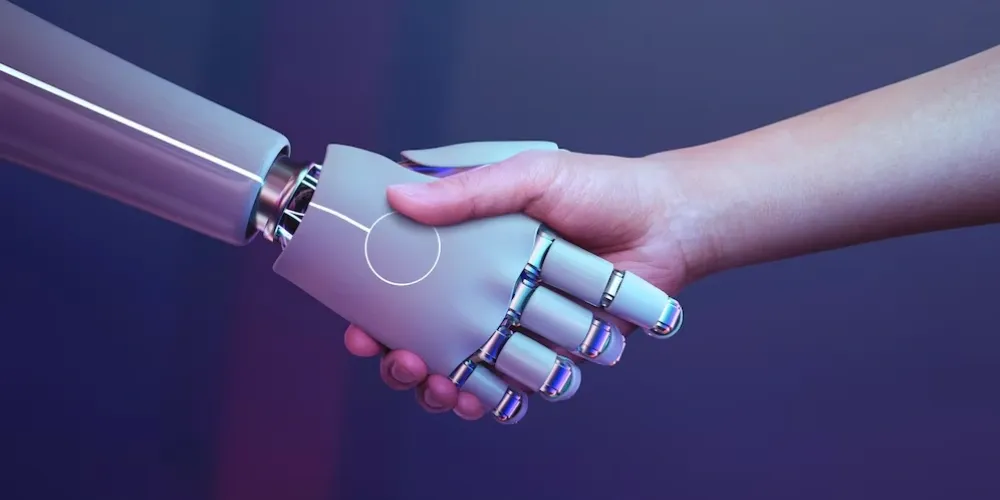
L'avènement de l'IA s'est avéré être un moment décisif pour la plupart des secteurs, et le paysage des récompenses et de la fidélisation ne fait pas exception à la règle.
Les entreprises exploitent déjà l'IA, l'apprentissage automatique et le traitement du langage naturel pour personnaliser, prédire et optimiser les résultats, et garder une longueur d'avance sur les attentes.
5. La gamification
La gamification apparaît comme une tendance marquante de 2025. 85% des employés s'engagent davantage lorsque la gamification est appliquée, et Microsoft a constaté un taux de rétention des employés supérieur de 40 % grâce à elle.
Les entreprises ajoutent une dose d'amusement et d'adrénaline à leurs activités et fonctions clés pour renforcer l'engagement, améliorer la maîtrise des compétences, garantir une gratification rapide, favoriser le lien social et augmenter le retour sur investissement. Cela leur permet également d'obtenir des informations essentielles sur la motivation et le comportement.
Les outils traditionnels tels que les points, les badges, les niveaux et les tableaux de classement sont associés à des technologies émergentes telles que l'IA, la réalité virtuelle, la réalité augmentée et les simulations immersives pour créer des expériences de gamification dynamiques, personnalisées et sophistiquées qui captent l'imagination des différentes catégories de générations : Millennials, Gen-Y, Gen-Alpha.
6. Du matérialisme à la mémoire
Le temps rivalise avec les poids lourds traditionnels tels que l'argent, l'estime et les biens matériels pour le titre de récompense la plus convoitée de 2025. Sur un marché des récompenses encombré, les équipes chargées des récompenses doivent donc innover davantage en matière d'équilibre entre vie professionnelle et vie privée, en aidant les membres à libérer du temps pour les choses qu'ils aiment.
7. Cibler les personnes peu fréquentes
Certaines marques commencent à s'intéresser à une catégorie ignorée : le client occasionnel, Emirates s'associe à des partenaires dans toutes les catégories afin d'apporter de la valeur aux voyageurs, même à ceux qui ne voyagent qu'une fois par mois. Qantas a investi 100 millions de dollars pour 20 millions de sièges de récompense supplémentaires.
IAG Loyalty permet aux clients d'accumuler des points même s'ils ne volent pas fréquemment avec une campagne qui s'intitule "Votre quotidien peut payer vos vacances !".
8. DXP
L'expérience client est un domaine clé pour les architectes des programmes de récompenses et de fidélisation. de nouvelles tendances et de nouveaux jouets: Interfaces neuro-réactives, dispositifs EEG portables, assistants numériques sensibles, réalité mixte immersive, modélisation améliorée par la méthode quantique, fils de clients numériques, reconnaissance vocale conversationnelle, appareils domestiques intelligents, conception mobile d'abord, intégration IoT, holographie, interfaces à interface zéro et plateformes CX cognitives, pour n'en citer que quelques-uns.
Une équipe hétéroclite qui se réunira sur des plates-formes d'expérience numérique (DXP) passionnantes où les organisations cherchent à augmenter leurs investissements. de 35 % au cours des trois prochaines années.
9. Sécurité
Saviez-vous que la fraude à la fidélisation était la quatrième type de fraude en croissance en 2024 ? Avec 53 % des clients s'inquiètent de la sécurité des informations personnelles, 2025 sera une année marquée par des préoccupations accrues en matière de piratage et des lois plus strictes sur la protection de la vie privée. Les entreprises devront faire preuve de transparence dans le traitement des informations relatives aux programmes de récompense et de fidélisation.
L'authentification et le chiffrement renforcés, la sécurisation des réseaux 5G, la reconnaissance profonde des faux, la sécurité du cloud et la sécurité de l'IoT vont détourner les conversations de la salle de conférence - peut-être plus fréquemment que nous ne le souhaiterions.










